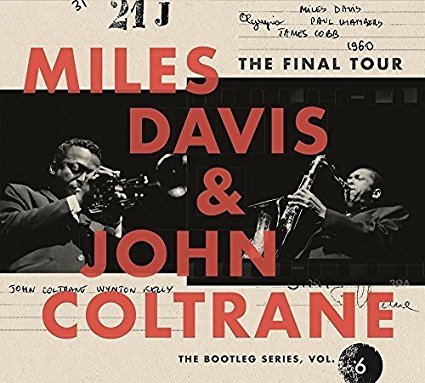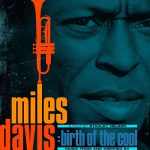Artist: Miles Davis & John Coltrane
Album: The Final Tour, The Bootleg Series, Vol. 6 (4 CDs)
Label: Columbia/Legacy
Release Date: 3.23.2018

=These long sought-out performances by collectors are now available in pristine sound quality—the official release of five concerts from the last tour of John Coltrane as a sideman, the inaugural European tour of the Miles Davis Band in 1960. Much in the way Dylan is remembered for going electric for the first at Newport, or when Miles went electric for the first time in fusion, these shows are not only historic but controversial too.
Miles and Trane were on different pages. Coltrane had reluctantly agreed to do the tour at the last minute and had already submitted his resignation. Miles was trying to bridge the gap between his standard fare from the ’50s and the modal revolution that Initiated. This is the band from that iconic album sans Cannonball Adderley—Wynton Kelly (piano), Paul Chambers (bass), Jimmy Cobb (drums). If you’ve seen the movie documentary on Coltrane—Chasin’ the Trane, you already know that Coltrane recorded his breakthrough Giant Steps album around the same time as Kind of Blue. Due to some dental issues and other reasons, the prolific Coltrane had not really performed or recorded much in the year leading up to these shows, yet he was well on the way (because we know how often he practiced) to formulating his aggressive avant-garde sound. He used these shows to introduce an unprepared audience to a previously unheard aggressive intensity, as if he was playing apart from the group and the rhythm section. He stands in vividly contrast to Miles’ muted, melodic passages which are also expressive but much more restrained. In effect, this represents three styles of music—the post-bop, often ballad-centered Miles music of the late ’50s, the modal vein of Kind of Blue, and Coltrane’s individualistic early avant-garde.
“I think he plays on that tour differently from how he plays on any other recording,” saaid saxophonist Simon Spillet. “You can hear the seeds of where he’s heading. He’s pushing the saxophone and its context to its limits. Already in his head he was hearing a very different accompaniment from what Wynton Kelly and Jimmy Cobb were giving him.” There’s an interview segment with Coltrane on the last disc where he is asked by a Swedish DJ whether he feels angry. Coltrane responded, “No, I don’t…the reason I play so many sounds, maybe it sounds angry, I’m trying so many things at one time. I haven’t sorted them out.”
Modal music is essentially staying on a single chord for an entire section. On Kind of Blue, the soloists glide above the rhythm section chasing melodies. Here, on the first track, “All of You,” and throughout, Coltrane’s patterns are anything but smooth. They are rough units of rhythm that disrupt the band’s continuity. He centers on one melodic idea, approaches it from every which way, until he completely exhausts it (and perhaps the audience too.) Coltrane told an interviewer in 1962 “I start from one point and go as far as possible. But, unfortunately, I never lose my way. I localize, which is to say that I think always in a given space. I rarely think of the whole of a solo, and only very briefly. I always return to the small part of the solo that I was in the process of playing. The harmonies have become for me a kind of obsession.”
The liner notes are written by Ashley Kahn in a 31-page booklet which should be mandatory reading. There are many passages worth citing. Here are just a couple: Coltrane to Downbeat on the tour: “I thought in groups of notes, not of one note at a time. I tried to place these groups on the accents and emphasize the strong beats…sometimes what I was doing clashed harmonically with the piano.” Or, this one where the iconic journalist, Ralph J. Gleason, noted to Miles that his music had become complicated enough to demand five saxophonists. Gleason remembered, “He shot those eyes at me, and growled, ‘I had five tenor players once.’ I knew what he meant.”
These shows took place in Paris, Copenhagen, and Stockholm and featured earlier Miles arrangements like “On Green Dolphin Street,” “All of You,” “’Round Midnight,” “Bye Bye Blackbird,” “Walkin’,”and “Oleo” with “So What” and “All Blues” from Kind of Blue. Hearing the divergent solos and a band desperately trying to keep it all together is fascinating. That, together with the magical production job, and the insights provided in the liners should earn this project Grammy recognition.
—Jim Hynes







Be the first to comment!